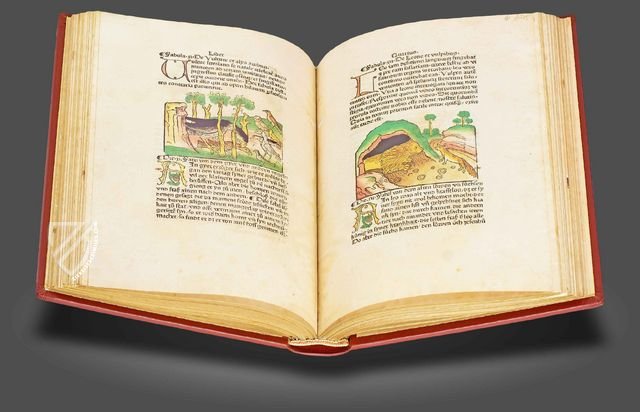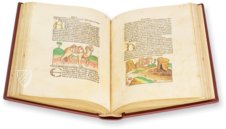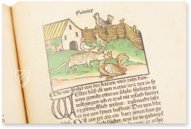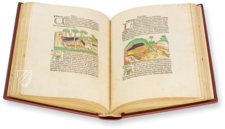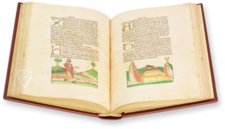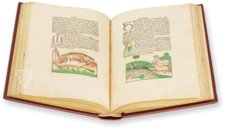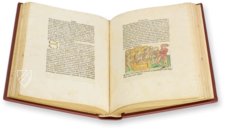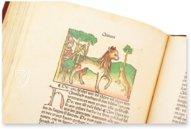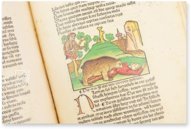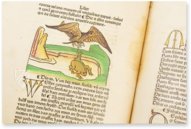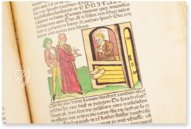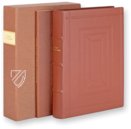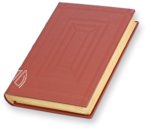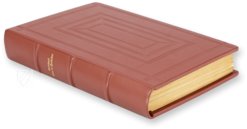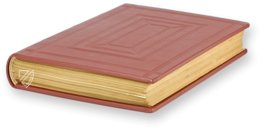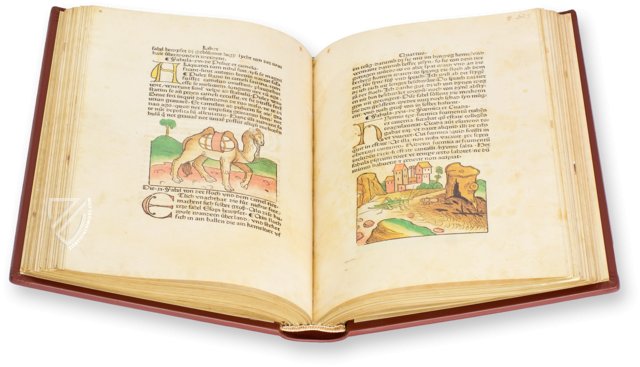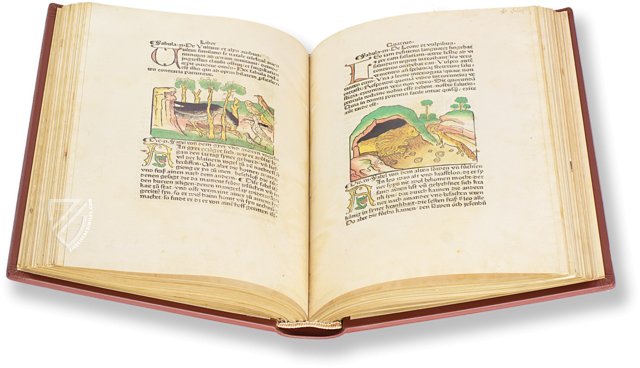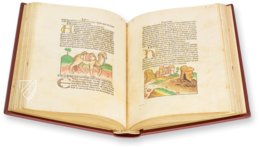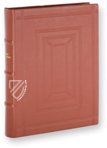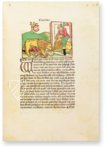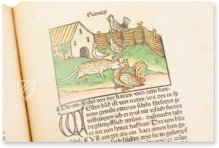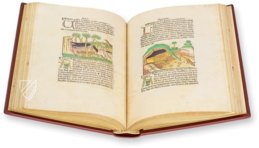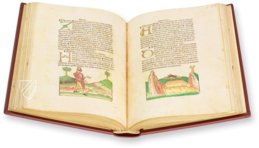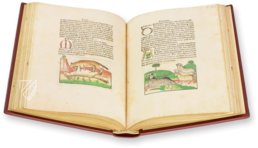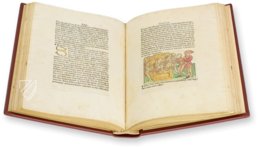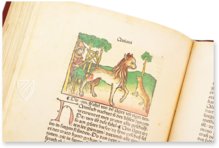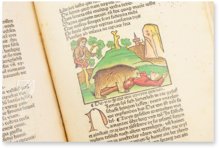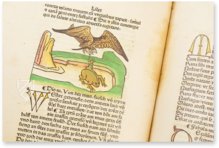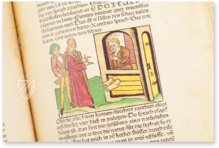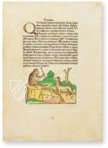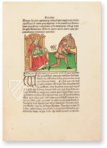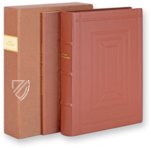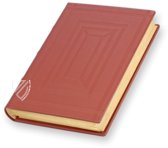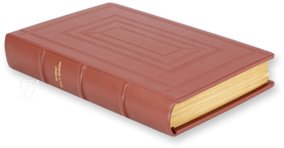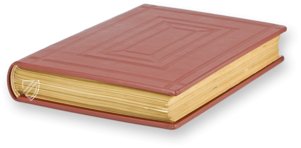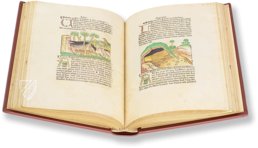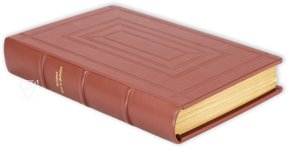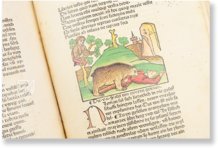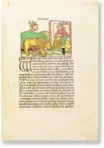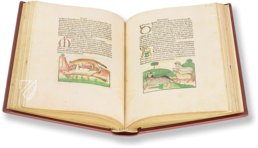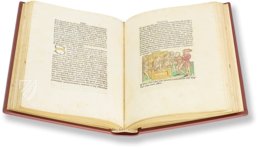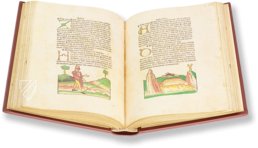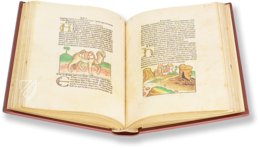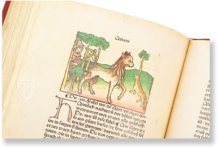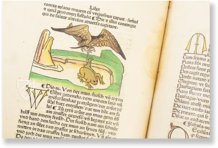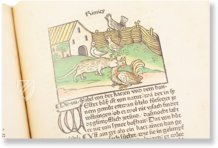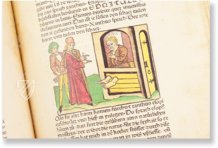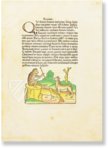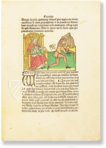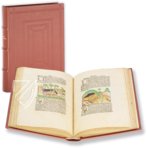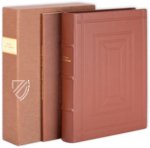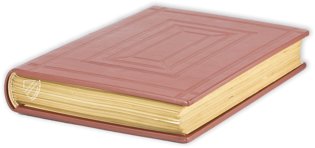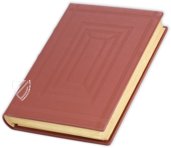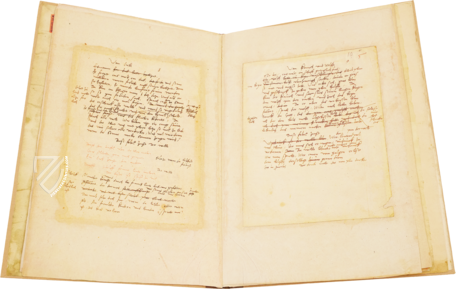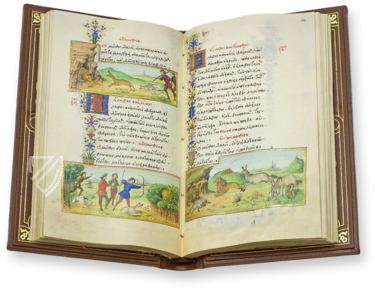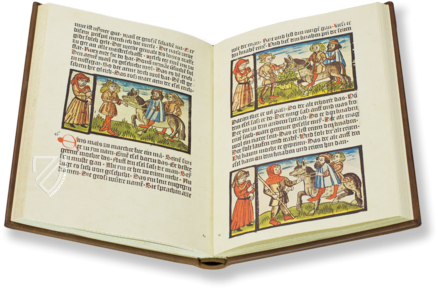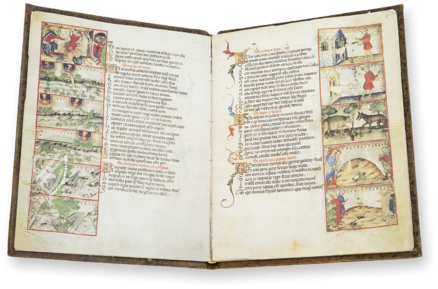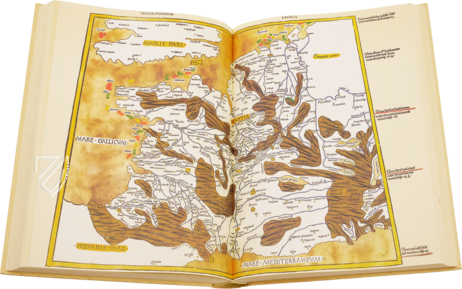Aesopus - Vita et Fabulae
(under 1,000€)
The so-called Ulm Aesop, published around 1476 by the Ulm humanist and translator Heinrich Steinhöwel, is one of the most important editions of Aesop's ancient fables and, with its more than 190 masterly coloured woodcuts, was stylistically influential for subsequent editions and other works. This early print from the workshop of Johann Zainer transports the entertaining and educational animal fables of the author, who was active in the 6th century BC, to the time of the emerging humanism in the German-speaking area. In the high-quality woodcuts by the famous master of the choir stalls in Ulm Minster, Jörg Syrlin the Elder, the ancient texts are brought closer to the reader, printed bilingually in Latin and German and supplemented by an enjoyable biography of Aesop. The (art) historically important codex is now kept in the Otto Schäfer Museum in Schweinfurt.
Aesopus - Vita et Fabulae
The so-called Ulm Aesop belongs among the most significant specimens of the fables by the ancient author Aesop in the history of book art. Published ca. 1476 by the Ulm humanist and translator Heinrich Steinhöwel, the book contains 190+ colored woodcuts across 550 pages. These are ascribed to Jörg Syrlin d. Ä., the famous Master of the Choir Stalls in the Ulm Minster. The Ulm Aesop was printed by Johann Zainer in the Ulmer Offizin and contains all of the Aesop’s Fables that were known at that time along with an entertaining biography of Aesop.
The Trendsetting Aesop Specimen
The entertaining and instructive animal fables by Aesop (ca. 620–560 B.C.E) still have meaning today. They founded the literary genre of moralizing fables. The stories have enjoyed great popularity and were handed down in numerous manuscripts and translations from Greek since antiquity and throughout the Middle Ages. With the invention of the printing press, Aesop’s Fables enjoyed a renewed heyday. The moralizing stories were illustrated with woodcuts in many editions. The most famous of these editions is the Ulm Aesop. The humanist and translator Heinrich Steinhöwel (1412–1482/3) published it in 1476 with Latin text and the German translation. In this way, he made the fables comprehensible for everyone. In his edition of Aesop, Steinhöwel assembled all of the known fables by Aesop at that time and an entertaining biography of Aesop, the author of the moralizing stories. Additionally, Steinhöwel attached a few tales by Poccio Bracciolini, a famous Italian Renaissance humanist, to his Aesop edition. The Ulm Aesop, printed by Johann Zainer, was style-forming for the following epochs. The Ulm Aesop was reprinted across all of Europe, though the impressive woodcuts of the original specimen from Ulm remain unparalleled.
Impressive Illustrations by a Great Master
Alongside the text by Heinrich Steinhöwel, the Ulm Aesop is impressive above all because of its artistic design. This is ascribed to Jörg Syrlin d. Ä. (ca. 1425–1491), the master of the Ulm Minster’s famous choir stalls. Over 190 woodcuts accompany the text. Both the plasticity and spatiality of the scenery as well as the design of the figures depicted are stylistically outstanding. Both animals as well as people are drawn with expressive facial expressions and gestures, which wonderfully render the content of the fables in gorgeous pictures. The various kinds of animals are additionally remarkable in their naturalistic depiction. In addition to the woodcuts, the text is designed with diverse colored initials. Aesop’s Fables, meant to be understood like parables, have lost nothing of their impressive and entertaining nature. Just as in antiquity, the Middle Ages, or the Renaissance, these tales, e.g. of the fox and the grapes or of the amorous lions, are a great pleasure both as entertaining literature as well as useful reading. The moralizing tales are crowned with colorful woodcuts by Jörg Syrlin in the famous specimen of the Ulm Aesop.
Codicology
- Alternative Titles
- Esopo - Vita e Favole
Ulmer Aesop
Aesop's Fables
Aesopus
Vita et Fabulae
Fables by Aesop of ca. 1476 - Size / Format
- 550 pages / 30.5 × 22.5 cm
- Origin
- Germany
- Date
- 1476
- Epochs
- Style
- Genre
- Illustrations
- 191 colored woodcut illustrations
- Artist / School
- Aesop (620–564 BC) (author)
Poccio Bracciolini (1380–1459) (author)
Johannes Zainer (printer)
Jörg Syrlin the Older (woodcuts)
Aesopus - Vita et Fabulae
The Man and the Lion
This colorful woodcut and the fable it illustrates are concerned with the difference between perception and reality as well as the importance of considering the facts before forming an opinion. Framed on the right is the artist's depiction of a heroic and fashionably-dressed man pouncing upon the lion. The reality of when a lion meets an unarmed man is shown on the ground to the left: a much humbler man being mauled as he tries to defend himself.
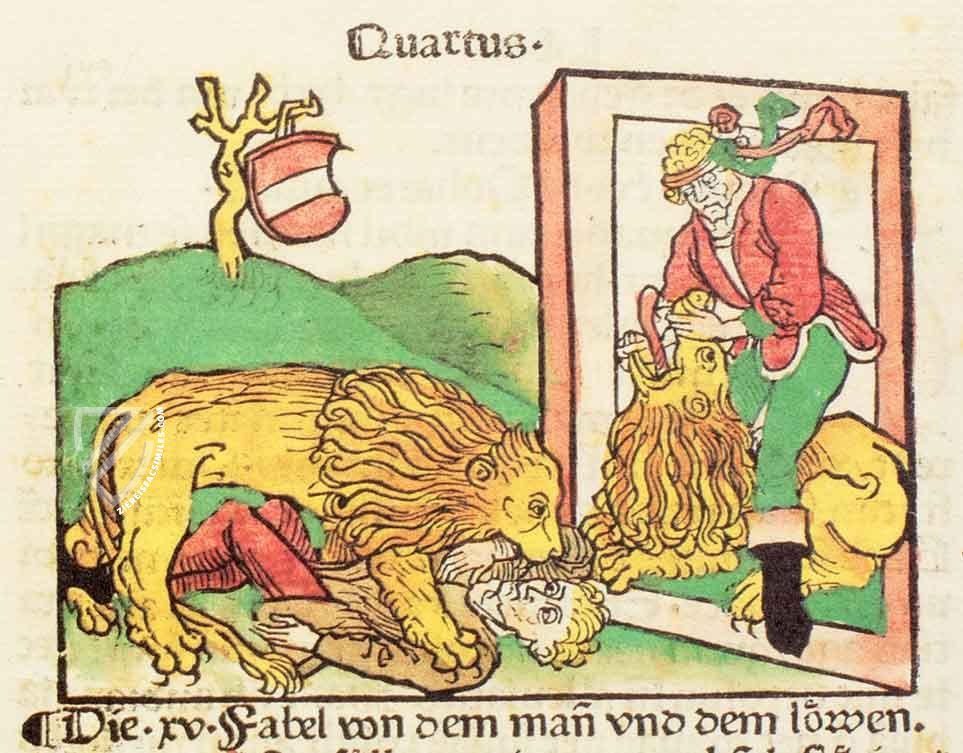
Aesopus - Vita et Fabulae
The Man and the Lion
In this fable, the moral of which is to examine the source of evidence before accepting it, man and lion debate which of them is more powerful. They stand before a painting showing a man wearing red and green seizing a lion by the jaws, which the man points to as evidence for his superiority.
The lion retorts that a man painted the scene, and that if a lion had, then it would be different. To prove his point, the lion pounces on the man, who has foolishly left his shield hanging on a bough in the background. This popular fable was later adapted by Geoffrey Chaucer in the “Wife of Bath,” who in defense of her sex demanded “Who painted the lion, tell me who?”
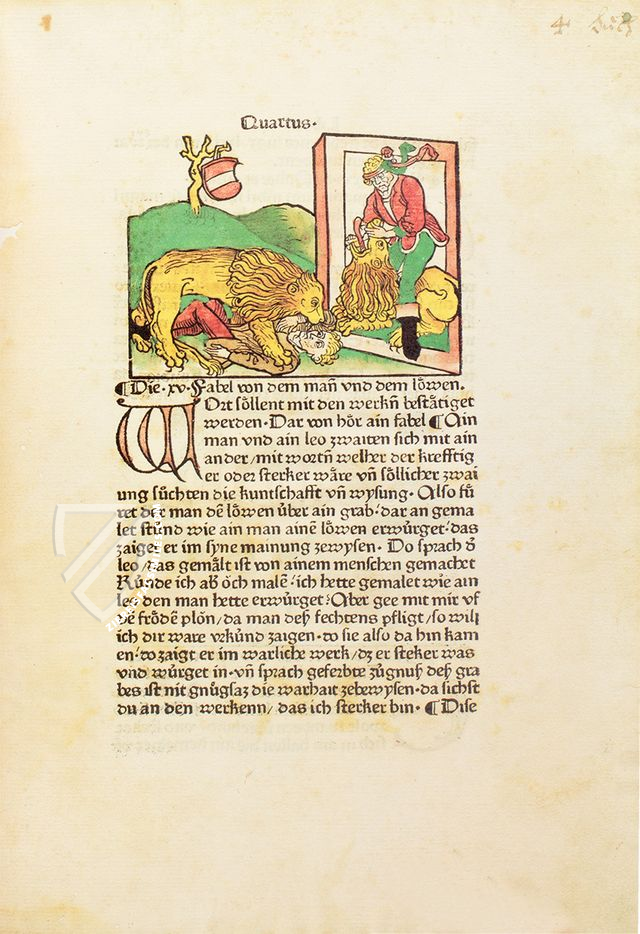
#1 Esopo - Vita e Favole
Languages: German or Italian
(under 1,000€)
#2 Aesopus - Vita et Fabulae
Language: German
(under 1,000€)
- Treatises / Secular Books
- Apocalypses / Beatus
- Astronomy / Astrology
- Bestiaries
- Bibles / Gospels
- Chronicles / History / Law
- Geography / Maps
- Saints' Lives
- Islam / Oriental
- Judaism / Hebrew
- Single Leaf Collections
- Leonardo da Vinci
- Literature / Poetry
- Liturgical Manuscripts
- Medicine / Botany / Alchemy
- Music
- Mythology / Prophecies
- Psalters
- Other Religious Books
- Games / Hunting
- Private Devotion Books
- Other Genres
- Afghanistan
- Armenia
- Austria
- Belgium
- Colombia
- Croatia
- Czech Republic
- Denmark
- Egypt
- Ethiopia
- France
- Germany
- Hungary
- India
- Iran
- Iraq
- Israel
- Italy
- Japan
- Luxembourg
- Mexico
- Morocco
- Netherlands
- Peru
- Poland
- Portugal
- Russia
- Serbia
- Spain
- Sri Lanka
- Sweden
- Switzerland
- Syria
- Turkey
- Ukraine
- United Kingdom
- United States
- Uzbekistan
- Aboca Museum
- Ajuntament de Valencia
- Akademie Verlag
- Akademische Druck- u. Verlagsanstalt (ADEVA)
- Aldo Ausilio Editore - Bottega d’Erasmo
- Alecto Historical Editions
- Alkuin Verlag
- Almqvist & Wiksell
- Amilcare Pizzi
- Andreas & Andreas Verlagsbuchhandlung
- Archa 90
- Archiv Verlag
- Archivi Edizioni
- Arnold Verlag
- ARS
- Ars Magna
- ArtCodex
- AyN Ediciones
- Azimuth Editions
- Badenia Verlag
- Bärenreiter-Verlag
- Belser Verlag
- Belser Verlag / WK Wertkontor
- Benziger Verlag
- Bernardinum Wydawnictwo
- BiblioGemma
- Biblioteca Apostolica Vaticana (Vaticanstadt, Vaticanstadt)
- Bibliotheca Palatina Faksimile Verlag
- Bibliotheca Rara
- Boydell & Brewer
- Bramante Edizioni
- Brepols Publishers
- British Library
- C. Weckesser
- Caixa Catalunya
- Canesi
- CAPSA, Ars Scriptoria
- Caratzas Brothers, Publishers
- Carus Verlag
- Circulo Cientifico
- Club Bibliófilo Versol
- Club du Livre
- CM Editores
- Collegium Graphicum
- Collezione Apocrifa Da Vinci
- Comissão Nacional para as Comemorações dos Descobrimentos Portugueses
- Coron Verlag
- Corvina
- CTHS
- D. S. Brewer
- De Agostini/UTET
- De Schutter
- Deuschle & Stemmle
- Deutscher Verlag für Kunstwissenschaft
- DIAMM
- Droz
- E. Schreiber Graphische Kunstanstalten
- Ediciones Boreal
- Ediciones Grial
- Ediclube
- Edições Inapa
- Edilan
- Editalia
- Edition Georg Popp
- Edition Leipzig
- Edition Libri Illustri
- Editiones Reales Sitios S. L.
- Éditions de l'Oiseau Lyre
- Editions Medicina Rara
- Editorial Casariego
- Editorial Mintzoa
- Editrice Antenore
- Editrice Velar
- Edizioni Edison
- Egeria, S.L.
- Eikon Editores
- Electa
- Enciclopèdia Catalana
- Eos-Verlag
- Ephesus Publishing
- Eugrammia Press
- Extraordinary Editions
- Fackelverlag
- Facsimila Art & Edition
- Facsimile Editions Ltd.
- Facsimilia Art & Edition Ebert KG
- Faksimile Verlag
- Feuermann Verlag
- Folger Shakespeare Library
- Franco Cosimo Panini Editore
- Friedrich Wittig Verlag
- Fundación Hullera Vasco-Leonesa
- G. Braziller
- Gabriele Mazzotta Editore
- Gebr. Mann Verlag
- Gesellschaft für graphische Industrie
- Getty Research Institute
- Giovanni Domenico de Rossi
- Giunti Editore
- Graffiti
- Grafica European Center of Fine Arts
- Guido Pressler
- Guillermo Blazquez
- H. N. Abrams
- Harrassowitz
- Helikon
- Hendrickson Publishers
- Henning Oppermann
- Herder Verlag
- Hes & De Graaf Publishers
- Hoepli
- Hortus Deliciarum
- Houghton Library
- Hugo Schmidt Verlag
- Idion Verlag
- Il Bulino, edizioni d'arte
- ILte
- Imago
- Insel Verlag
- Instituto de Estudios Altoaragoneses
- Instituto Nacional de Antropología e Historia
- Istituto dell'Enciclopedia Italiana - Treccani
- Istituto Ellenico di Studi Bizantini e Postbizantini
- Istituto Geografico De Agostini
- Istituto Poligrafico e Zecca dello Stato
- Italarte Art Establishments
- J. Thorbecke
- Jan Thorbecke Verlag
- Johnson Reprint Corporation
- Jugoslavija
- Karl W. Hiersemann
- Kasper Straube
- Kaydeda Ediciones
- Konrad Kölbl Verlag
- Kurt Wolff Verlag
- La Liberia dello Stato
- La Linea Editrice
- La Meta Editore
- Lambert Schneider
- Landeskreditbank Baden-Württemberg
- Leo S. Olschki
- Les Incunables
- Library of Congress
- Libreria Musicale Italiana
- Lichtdruck
- Lito Immagine Editore
- Lumen Artis
- Lund Humphries
- M. Moleiro Editor
- Maison des Sciences de l'homme et de la société de Poitiers
- Manuscriptum
- Maruzen-Yushodo Co. Ltd.
- MASA
- McGraw-Hill
- Militos
- Millennium Liber
- Müller & Schindler
- National Library of Wales
- Neri Pozza
- Nova Charta
- Oceanum Verlag
- Odeon
- Orbis Mediaevalis
- Orbis Pictus
- Österreichische Staatsdruckerei
- Oxford University Press
- Pageant Books
- Parzellers Buchverlag
- Patrimonio Ediciones
- Pattloch Verlag
- PIAF
- Pieper Verlag
- Plon-Nourrit et cie
- Prestel Verlag
- Princeton University Press
- Prisma Verlag
- Priuli & Verlucca, editori
- Pro Sport Verlag
- Propyläen Verlag
- Pytheas Books
- Quaternio Verlag Luzern
- Reales Sitios
- Recht-Verlag
- Reichert Verlag
- Reichsdruckerei
- Riehn & Reusch
- Roberto Vattori Editore
- Rosenkilde and Bagger
- Roxburghe Club
- Salerno Editrice
- Sarajevo Svjetlost
- Schöck ArtPrint Kft.
- Scolar Press
- Scrinium
- Scripta Maneant
- Scriptorium
- Siloé, arte y bibliofilia
- SISMEL - Edizioni del Galluzzo
- Sociedad Mexicana de Antropología
- Sorli Ediciones
- Stainer and Bell
- Styria Verlag
- Sumptibus Pragopress
- Szegedi Tudomànyegyetem
- Taberna Libraria
- Tarshish Books
- Taschen
- Tempus Libri
- Testimonio Compañía Editorial
- Thames and Hudson
- The Clear Vue Publishing Partnership Limited
- The Facsimile Codex
- The Folio Society
- The Marquess of Normanby
- The Richard III and Yorkist History Trust
- Tip.Le.Co
- TouchArt
- TREC Publishing House
- TRI Publishing Co.
- Trident Editore
- Typis Regiae Officinae Polygraphicae
- Universidad de Granada
- University of California Press
- University of Chicago Press
- Urs Graf
- Vallecchi
- Van Wijnen
- VCH, Acta Humaniora
- VDI Verlag
- Verlag für Regionalgeschichte
- Verlag Styria
- Vicent Garcia Editores
- W. Turnowsky
- Wiener Mechitharisten-Congregation (Wien, Österreich)
- Wissenschaftliche Buchgesellschaft
- Xuntanza Editorial
- Zollikofer AG

